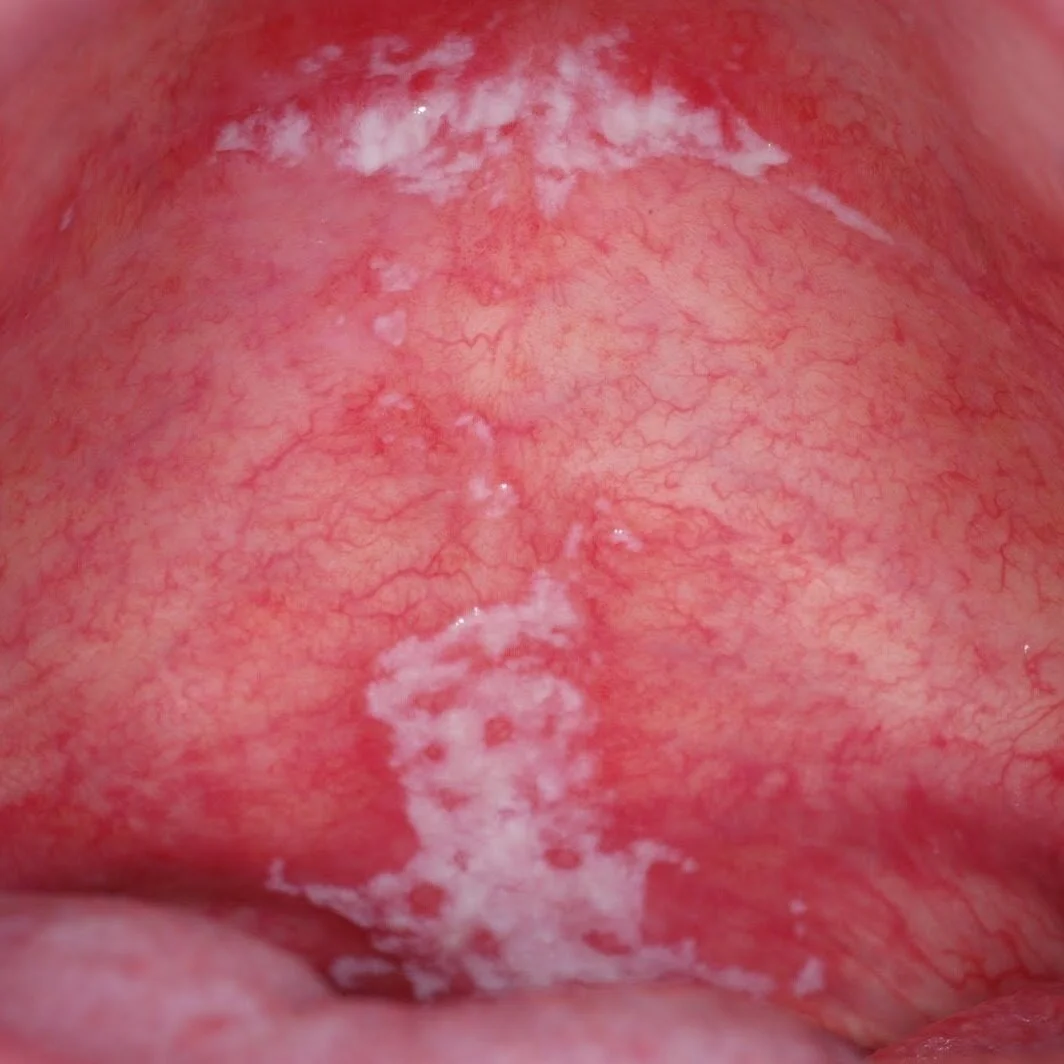Oral Yeast infections (Thrush and Candidiasis)
Disclaimer
This post is not intended to diagnose, treat, or cure any condition. It is intended for informational purposes only. Consult with your dentist if you have any questions about the status of your mouth.
Oral plaque is composed primarily of bacteria. Researchers have identified approximately one hundred species of fungus inhabiting the human mouth as well, and they are collectively known as the mycobiota. (1 ) The dominant species in the mycobiota is Candida Albicans, which is a type of yeast. Exposure to maternal colonies during birth results in ten to fifteen percent of babies having C. Albicans present in their mouths. (2) The percentage of people who host it rises with age to around seventy-five percent. (3) In healthy individuals with good oral hygiene, the presence of yeast in the mouth does not pose a problem.
Certain situations can cause the yeast to become virulent, causing symptoms. The behavior of plaque, a subset of our gut microbiota, depends on many factors including diet, health, oral hygiene, the presence of dentures and other appliances, dental procedures, medications, sleep, stress, and other infections. (4,5) You can read more about how plaque changes can lead to problems in this previous post. Candidiasis is the general term for the overgrowth of yeast. The common underlying condition that results in the pathologic behavior of Candida is a weakened immune system. (6) Changes in bacteria by antibiotics and corticosteroids may also increase oral Candida growth in humans. (7) Steroid asthma inhalers are frequently the cause of oral candidiasis.
Diagnosis
Clinical observation is the primary method of diagnosis. Although biopsy and culture analysis can differentiate it from other similar appearing conditions. (8) Candidiasis has a few different forms depending on its location and appearance. These include thrush, denture stomatitis, angular cheilitis, median rhomboid glossitis, and linear gingival erythema, which I will describe below. (9)
Thrush
The most common form of thrush is also known as pseudomembranous candidiasis. It appears as easily removable white plaques on the tongue, cheeks, and gums. Reddened tissues generally underlie the white film. The locations are variable, and the symptoms can range from asymptomatic to painful. A “hyperplastic” variation exists where the film is not removable. Hyperplasia means overgrowth. In this form, the underlying tissues grow and become white. (10, 11)
Denture Stomatitis
Denture Stomatitis (chronic atrophic erythematous candidiasis) arises when dentures and other appliances contact the mucous membranes of the mouth, creating ideal conditions for yeast to thrive. The tissues involved will be limited to areas of contact and appear smooth and red. This condition rarely causes pain unless the appliance is irritating the area. (12) Acute forms due to infections like HIV can look identical to denture stomatitis.
Angular Cheilitis
Angular Cheilitis is limited to the corners of the mouth. It generally appears as split skin and is usually painful. It arises when there are excessive folds due to lack of teeth or poorly fitting dentures. Other causes are constant licking of the area, vitamin B deficiency, HIV and other infections, sagging skin, and iron deficiency. (13)
Median Rhomboid Glossitis
Median Rhomboid Glossitis is rare and appears as a smooth red patch in the middle of the tongue. It is usually not symptomatic. It is typically due to inhaled steroid use and smoking.
Linear Gingival Erythema
Infections like HIV or mouth breathing cause Linear Gingival Erythema. It appears as appears reddened gums and can be mildly symptomatic. (13)
Treatment
Treatment of oral candida infections involves removing the underlying conditions that may be contributing to the situation. Steroid use and antibiotics are the most common causes. The cessation of antibiotics in the instance of antibiotic-induced candidiasis and withdrawal from steroids in steroid-induced cases is useful but not practical. Treating and managing underlying diseases is the primary goal, but causative conditions take time to heal. Therefore medications to treat yeast overgrowth are frequently used during this period. Hence, prescription antifungal medications are standard.
Anti-fungal medications come in many varieties, but Nystatin rinses are the most commonly prescribed form. Alternatives to prescription antifungals do exist. Monolaurin is an effective over-the-counter treatment. Trimming and repairing dentures, and recommending keeping them out at night help in the case of denture stomatitis. Routine at-home denture and dental appliance disinfection is required, as well.
Since yeast thrives on carbohydrates, reducing or eliminating processed carbs is an excellent idea. Iron and vitamin B deficiency are common causes of candida overgrowth. Nutrient-dense diets will alleviate deficiencies over time and are a must for any health-conscious person. Smoking cessation is a no-brainer.
Dry-mouth syndrome is a bit more tricky. Depending on the cause, stress and sleep management may be the way to go. Mouth tape can be helpful in the case of mouth breathing. Xylimelts can be very helpful. Staying hydrated is essential in all situations. Lastly, good oral hygiene is critical.
Summary
1. Steroid use, antibiotics, severe illness and dental appliances are the typical causes of oral yeast overgrowth.
2. Treating the underlying conditions will ultimately lead to the resolution of the infection.
3. Topical antifungals and monolaurin help resolve infections.
4. Lifestyle changes are vital to healing and preventing yeast overgrowth.









